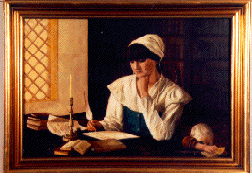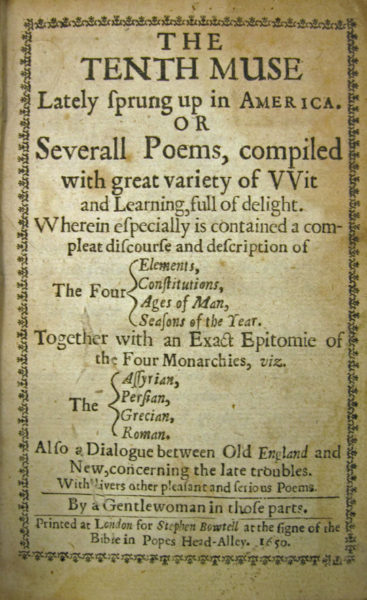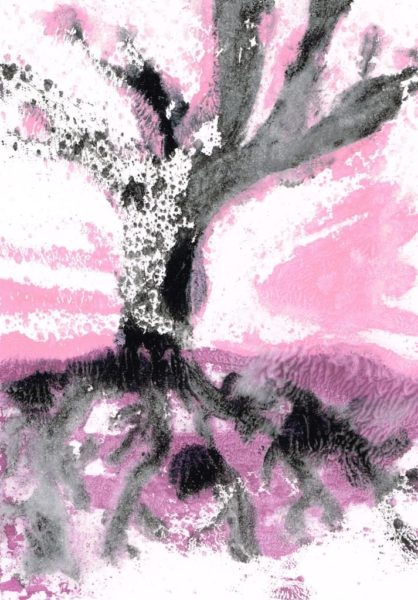 Anne Bradstreet (1612-1672,) born in Northampton, England to Thomas Dudley and Dorothy Yorka, was arguably the first writer in colonial America to be published. Anne wrote from the perspective of a Puritan woman who was both educated and devoted to seeking meaning within her religious heritage. In addition to her many household responsibilities, she wrote poetry, much of it focused on the details of a seventeenth century American woman’s life, her struggles in the new land, and her Puritan faith.
Anne Bradstreet (1612-1672,) born in Northampton, England to Thomas Dudley and Dorothy Yorka, was arguably the first writer in colonial America to be published. Anne wrote from the perspective of a Puritan woman who was both educated and devoted to seeking meaning within her religious heritage. In addition to her many household responsibilities, she wrote poetry, much of it focused on the details of a seventeenth century American woman’s life, her struggles in the new land, and her Puritan faith.
As a child in England, Anne was very well educated. She received tutoring in history, natural science, literature, and several foreign languages. She married Simon Bradstreet at the age of 16, emigrating to Massachusetts with him and her parents only 2 years later, as part of the Winthrop Fleet Puritan migration in 1630.
Six decades later she would write of that time, “I found a new world and new manners, at which my heart rose [in rebellion.] But after I was convinced it was the way of God, I submitted to it and joined to the church at Boston.”
Her family moved several times in those early years, always to more remote frontier regions. They finally settled in Newe Towne, which is now Cambridge, Massachusetts, and her first son Samuel was born there in 1632. Both her father and husband were instrumental in the formation of Harvard University, which was founded in 1636, and later they also served as governors of Massachusetts. In 1646, pregnant with their sixth child, Anne and Simon moved a sixth time, joining five other families to establish the community of North Andover, Massachusetts. Life in America was difficult, but Anne was able to cling to her faith and remain strong in the face of life’s adversities.
 Anne’s first book of poetry was “The Tenth Muse Lately Sprung Up in America,” which was published in London in 1650 and received acclaim in both the Old and New Worlds. Her early poetry was heavily influenced by Guillaume de Salluste Du Bartas, whose work she greatly admired. However, in her later work, she developed her own voice and wrote poems that were more personal and original, often focusing on subjects that were uniquely feminine in perspective.
Anne’s first book of poetry was “The Tenth Muse Lately Sprung Up in America,” which was published in London in 1650 and received acclaim in both the Old and New Worlds. Her early poetry was heavily influenced by Guillaume de Salluste Du Bartas, whose work she greatly admired. However, in her later work, she developed her own voice and wrote poems that were more personal and original, often focusing on subjects that were uniquely feminine in perspective.
One of her most famous poems “Upon the Burning of Our House July 10th, 1666,” conveys her refusal to focus on the loss of her possessions, including a large library of books; instead she looks to God for comfort.
She also wrote these wonderful lines about her love for Simon: “If ever two were one, then surely we/If ever man were loved by wife, then thee/If ever wife was happy in a man/Compare with me, ye women, if you can.”
Here is Anne’s poem that I plan to include in my book and the acrylic monoprint that I made to go with it:
 By nature Trees do rot when they are grown,
By nature Trees do rot when they are grown,
And Plumbs and Apples thoroughly ripe do fall,
And Corn and grass are in their season mown,
And time brings down what is both strong and tall.
But plants new set to be eradicate,
And buds new blown, to have so short a date,
Is by His hand alone that guides nature and fate.
Anne Bradstreet (1665)
Anne Bradstreet was a good and courageous woman, who somehow made time to write and reflect, with both scholarly and womanly perspectives, on daily life in seventeenth century America.
As Adrienne Rich wrote, “it is worth observing that Anne Bradstreet happened to be one of the first American women, inhabiting a time and place in which heroism was a necessity of life, and men and women were fighting for survival, both as individuals and as a community. To find room in that life for any mental activity which did not directly serve certain spiritual ends, was an act of great self-assertion and vitality. To have written poems, the first good poems in America, while rearing eight children, lying frequently sick, keeping house at the edge of wilderness, was to have managed a poet’s range and extension within confines as severe as any American poet has confronted.”
Reference: Hensley, Jeannine ed., “The Works of Anne Bradstreet,” Belknap Press of Harvard University, Cambridge, MA, 1967.
Image 1: Painting by LaDonna Gulley Warrick, Harvard Square Library, www.harvardsquarelibrary.org.
Image 2: Title page from “The Tenth Muse Lately Sprung Up in America,” Wikimedia Commons – public domain.















1 Comment
Leave your reply.